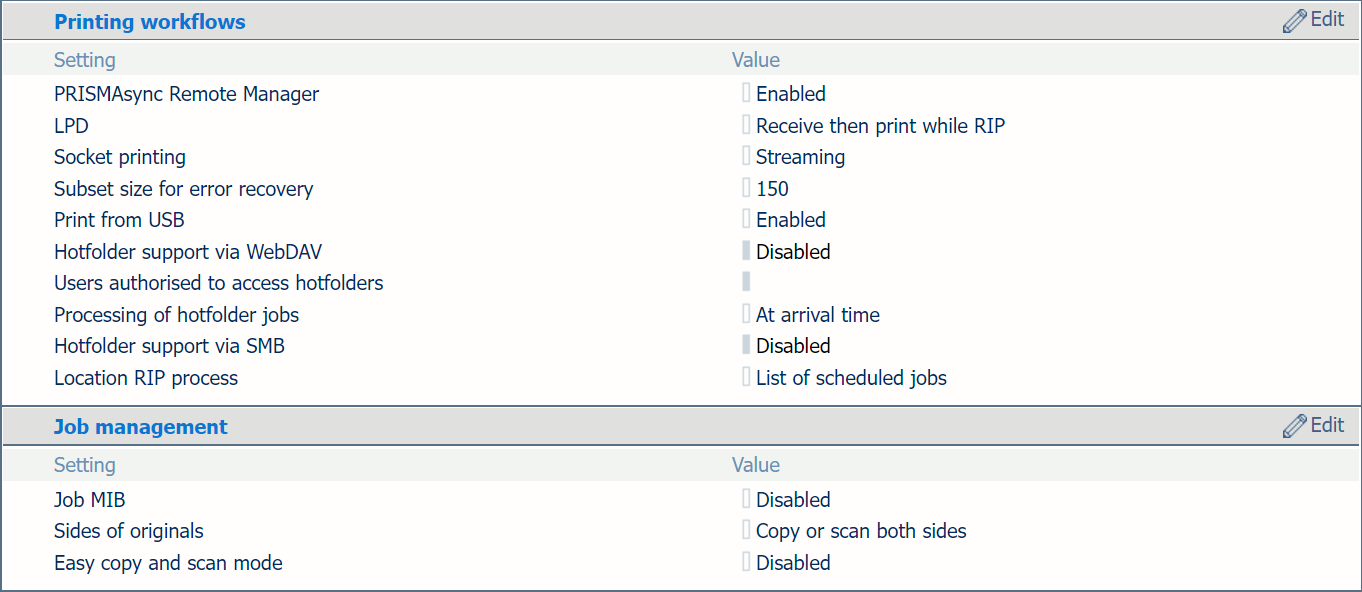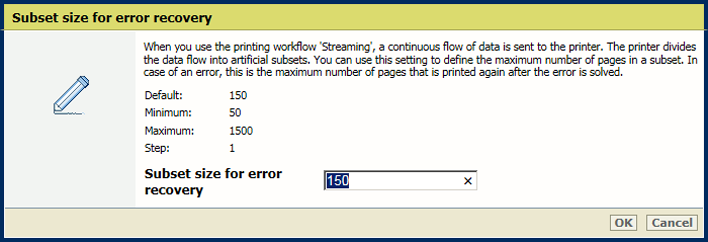

You can define how jobs are processed by default.
Open the Settings Editor and go to: .
 [Ajustes del sistema] tab
[Ajustes del sistema] tabGo to the [Flujos de trabajo de impresión] and [Gestión de trabajos] sections.
 [Flujos de trabajo de impresión] and [Gestión de trabajos] sections
[Flujos de trabajo de impresión] and [Gestión de trabajos] sectionsThe printer protocol LPD can be enabled by the system administrator. The print protocol LPR must be installed on the workstation that submits the jobs.
Use the [LPD] setting to indicate when the RIP starts to process LPR jobs.
[Flujo] is applicable to large jobs. The job is processed by the RIP and printing can start at the same time.
[Recibir e imprimir durante RIP] is the default value and is applicable to smaller jobs that have multiple sets. The RIP starts to process the jobs after they arrive in the print queue and before the whole job has been received.
 [LPD] setting
[LPD] settingSocket printing can be enabled and configured by the system administrator.
Use the [Impresión de zócalos] setting to indicate when the RIP starts to process jobs that use the socket printing port.
[Flujo]: is default value and applicable to large jobs. The job is processed by the RIP and printing can start at the same time.
[Recibir e imprimir durante RIP]: is applicable to for smaller jobs that have multiple sets. The RIP starts to process the jobs after they arrive in the print queue and before the whole job has been received.
 [Impresión de zócalos] setting
[Impresión de zócalos] settingUse the [Tamaño de subjuego para la recuperación tras errores] setting to define the number of pages that will be printed again after the error is solved.
 [Tamaño de subjuego para la recuperación tras errores] setting
[Tamaño de subjuego para la recuperación tras errores] settingThe system administrator can change the processing order of hotfolder jobs.
Use the [Procesamiento de trabajos de carpeta activa] setting to indicate how jobs are processed in the hotfolder.
[En función de la hora de llegada]: job processing takes place when the job arrives in the hotfolder.
[Orden basado en el nombre del trabajo]: job processing takes place according to the alphabetical order of the job names.
 [Procesamiento de trabajos de carpeta activa] setting
[Procesamiento de trabajos de carpeta activa] settingUse the [Impresión desde USB] setting to indicate whether printing from a USB drive is allowed.
 [Impresión desde USB] setting
[Impresión desde USB] settingUse the [Ubicación de proceso RIP] setting to indicate where the RIP processes jobs when they arrive in the print queue.
[Todas las ubicaciones]: the RIP can process jobs in all job destinations.
[Lista de trabajos programados]: the RIP can only process jobs when they are in the list of scheduled jobs.
 [Ubicación de proceso RIP] setting
[Ubicación de proceso RIP] settingUse the [Trabajo MIB] setting to indicate if remote monitoring of jobs via SNMP is allowed.
 [Trabajo MIB] setting
[Trabajo MIB] settingUse the [Caras de originales] setting to indicate if originals have information on one or both sides.
 [Caras de originales] setting
[Caras de originales] settingUse the [Modo sencillo de copia y captura] setting to indicate that you want to enable the easy copy and scan mode.
[Activado]: the last used job template will be re-opened when the operator starts a new copy or scan job.
[Deshabilitado]: the last used job template will close when the operator starts a new copy or scan job.
 [Modo sencillo de copia y captura] setting
[Modo sencillo de copia y captura] setting